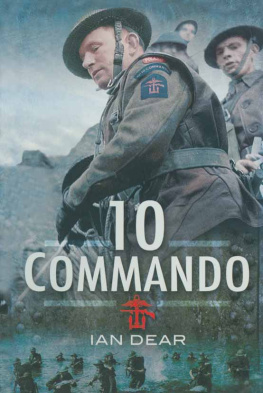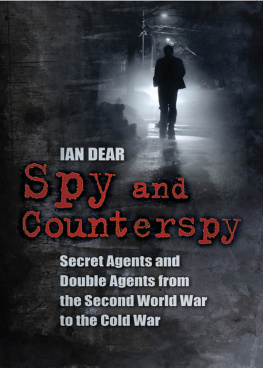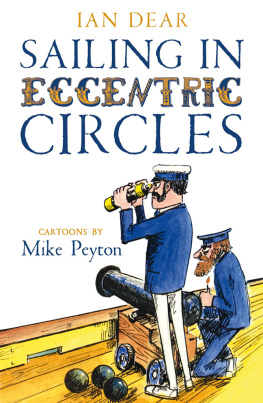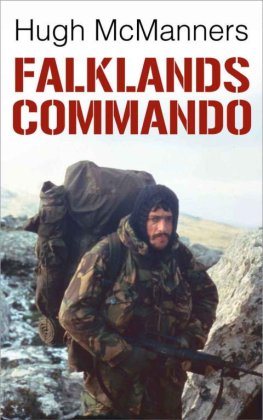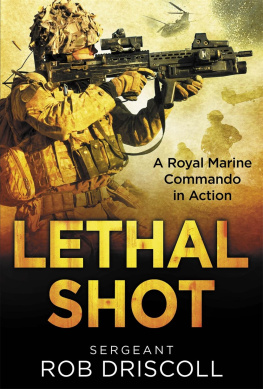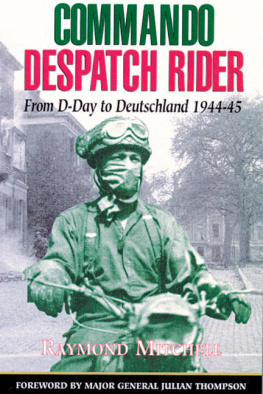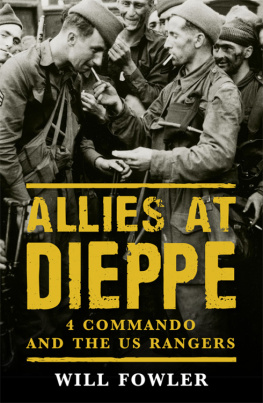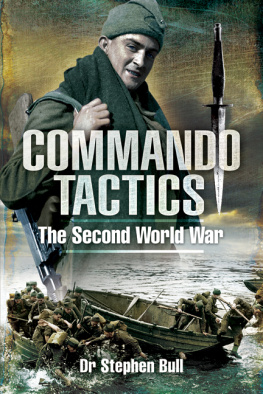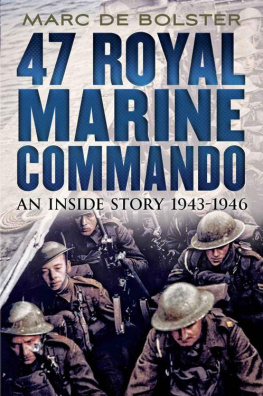TEN COMMANDO
TEN COMMANDO
19421945
Ian Dear

Published in the United States of America in 1989
First published in Great Britain in 1987
by Leo Cooper
Reprinted in this format in 2010 by
Pen & Sword Military
an imprint of
Pen & Sword Books Ltd
47 Church Street
Barnsley
South Yorkshire S70 2AS
Copyright Ian Dear 1987, 1989, 2010
ISBN 978 1 84884 400 1
The right of Ian Dear to be identified as
author of this work has been asserted by him in accordance
with the Copyright, Designs and Patents Act 1988
A CIP catalogue record for this book
is available from the British Library
All rights reserved. No part of this book may be reproduced or transmitted
in any form or by any means, electronic or mechanical including
photocopying, recording or by any information storage and retrieval
system, without permission from the Publisher in writing.
Typeset in Sabon 10.5/12pt by
Concept, Huddersfield
Printed and bound in England
by CPI
Pen & Sword Books Ltd incorporates the imprints of
Pen & Sword Aviation, Pen & Sword Maritime, Pen & Sword Military,
Wharncliffe Local History, Pen & Sword Select,
Pen & Sword Military Classics and Leo Cooper.
For a complete list of Pen & Sword titles please contact
PEN & SWORD BOOKS LIMITED
47 Church Street, Barnsley, South Yorkshire, S70 2AS, England
E-mail: enquiries@pen-and-sword.co.uk
Website: www.pen-and-sword.co.uk
The co-operation and hard work of many people made this book possible. Firstly, I would like to thank Henry Brown, Secretary of the Commando Association, who over a number of years has never failed to help and give wise counsel.
Next, I would like to thank the team of translators who struggled with unfamiliar military terms and phrases with unfailing good humour: Eve-Marie Wagner, Anne Griffiths, Marie-Madeleine Avit and Caroline (French); Hedwig Woerdman, Daemian J. Van Doorninck (Dutch); Ellen Stevens (Norwegian); Mary Stephens, Ted Monsior, Jerzy Lisowski (Polish).
Then there are the many individuals who helped me in one way or another to gather the material for this book. George Lane and Dr John Coates both offered me encouragement in its early stages and gave me valuable leads. To supplement reports in the Public Record Office, or the books and articles that have been written about the different Troops that made up the Inter-Allied Commando, I have either interviewed, or corresponded with (directly or indirectly), the following, and I am extremely grateful for their co-operation:
French: Flix Grispin, Lt-Colonel Robert Dawson, Jean Zivohlava, Maurice Chauvet, Dr Guy Vourch, Alex Lofi, Mme Kieffer, Jean Pinelli, Laurent Casalonga, Rupert Curtis.
Dutch: Brigadier-General Jan Linzel, Rudy Blatt, Peter Tazelaar, Willem van der Veer, Nick de Koning, Martin Knottenbelt, Bob Michels, W. de Waard, W. Boersma, Bill de Liefde, G.P. Ubels, C. G. Offerman, C. de Ruiter, W. G. van Gelderen, J. G. van den Bergh, E. C. D. J. de Roever; the Secretary of the Dutch Commando Association; Dr P. H. Kamphuis, Lt-Colonel Leunissen, Guido Zembsch-Schreve.
X-Troop: Colin Anson, R. G. Barnes, K. W. Bartlett, G. Broadman, Keith Douglas, Vernon I. Dwelly, John Envers, Anthony Firth, E. H. Fraser, Manfred Gans, H. Geiser, R. Gilbert, Judge H. B. Grant, Ian Harris, George Kendal, George Lane, K. E. Levy, Peter Masters, Michael Merton, J. F. McGregor, G. P. Nell-Nichols, Harry Nomburg, Stephan Ross, Professor Paul Streeten, Peter Terry, R. W. Tennant, A. C. Turner, W. J. Watson, Roger Kingsley, George Saunders, James Leasor, Keith Thompson, Sir Maxwell Harper Gow, Michael Arton, Ken Wright; SOE Archivist; Brigadier Peter Young, Miss Pat Cleland, J. E. Day.
Belgians: Maj-General Baron Danloy, Carlo G. Segers, Paul Dufrane, Fred Laurent, George van den Bossche.
Norwegians: Arne Srbye, Colonel Daniel Rommetvedt, Kaspar Gudmundseth, Arnfinn Haga, Alf Pettersen, Lt-Col Olav Gausland, Mrs Aslaug Risnes, R. W. Nilsen.
Poles: Ted Monsior, Maciej Zajaczkowski, A. J. Jedwab, Leo Licht, Zbigniew Gasiewicz; Archivist of Sikorski Museum.
Yugoslavs: Mario Mikolic, Press Attach, Yugoslavian Embassy; Director of the Muzej Revolucije Naroda, Beograd; Librarian of the Canadian War Museum; Ronald Mitchell.
The following also gave me general information on the Inter-Allied Commando: Dr John Coates, Lt-Col. Godfrey Franks, Maj-General Tom Churchill, Lord Lovat, Thomas Connolly, Group-Captain K. S. Batchelor, William Beynon, John Miller-Stirling, Donald Bradford; Archivist of Broadlands Museum; Secretary of the Special Forces Club; Philip Ziegler, Lady Laycock, Dr Tony Hodges, the Hon Mrs Miriam Lane; and Paul Powell, who took enormous trouble in tracking down the citations for British decorations awarded to members of the Commando.
Finally, there are those who very kindly vetted the manuscript or parts of it: Brigadier-General Jan Linzel, Maj-General Baron Danloy, Colonel Daniel Rommetvedt, Lt-Colonel Robert Dawson, Flix Grispin, Dr Guy Vourch Arne Srbye, George Lane, Carlo G. Segers, Peter Masters, Peter Terry.
It hardly seems possible that there is a non-fiction subject connected with the military aspect of the Second World War that has not been covered by historians, biographers, autobiographers, hagiographers or novelists.
Yet while I was researching a book on the Royal Marines I came across a brief reference to a unit called 10 (Inter-Allied) Commando. Intrigued, I turned to that excellent reference book on the Commandos, The Green Beret, by Hilary St George Saunders. It is 362 pages long, but not more than twelve are devoted to the Inter-Allied Commando. Yet he said enough to tell me that it must have been one of the most unusual units to have operated from Britain during the war, for it was made up of men whose own countries had been occupied by the Nazis. Even odder, to my mind, was the fact that the unit also contained a Troop of Germans!
I wanted to know more, but no detailed history of the unit had been published. So I checked every Commando history and then every published memoir, and from a page here and a page there the vaguest of outlines emerged. While I was doing this James Leasor published his book, The Unknown Warrior, which was based on information given to him by Lord Mountbatten and by Maj-General Sir Leslie Hollis, Senior Military Assistant Secretary to the War Cabinet and Chief of Staff Committee during the Second World War. This told the story of Stephen Rigby, who, according to Mountbatten and Hollis, had been a German member of the Inter-Allied Commando. It showed me that many members of the Commando were still alive, sane and, apparently, approachable.
But what really clinched it for me was the day I met George Lane. We had been introduced about an entirely different matter. Because I mentioned I had just finished my book about the Royal Marines George told me that he had been not only a member of 10 (IA) Commando but of the mysterious X-Troop which contained enemy aliens who spoke perfect German; that he was in fact a Hungarian by birth who had changed his name from Lanyi to Lane. I discovered later that he had been captured during a pre-D-Day reconnaissance raid, had been taken before Rommel for interrogation without betraying his real identity and had subsequently been awarded the Military Cross. I knew then that if the Inter-Allied Commando had been made up of men like this I had a book to write.
It has not proved an easy task, for practically all the published literature on the Commando is in Norwegian, Polish, Dutch and French, and it all had to be translated to extract the necessary information. Published details of X-Troop were sparse, so surviving members had to be interviewed and I also talked to many members of the other Troops, several of whom married British wives and settled in Britain; while others, of course, returned to their own countries and I had to track them down there. A third and vital source was the Public Record Office at Kew whose files yielded a treasure trove of information on the units activities, much of which has never previously been published.
Next page
